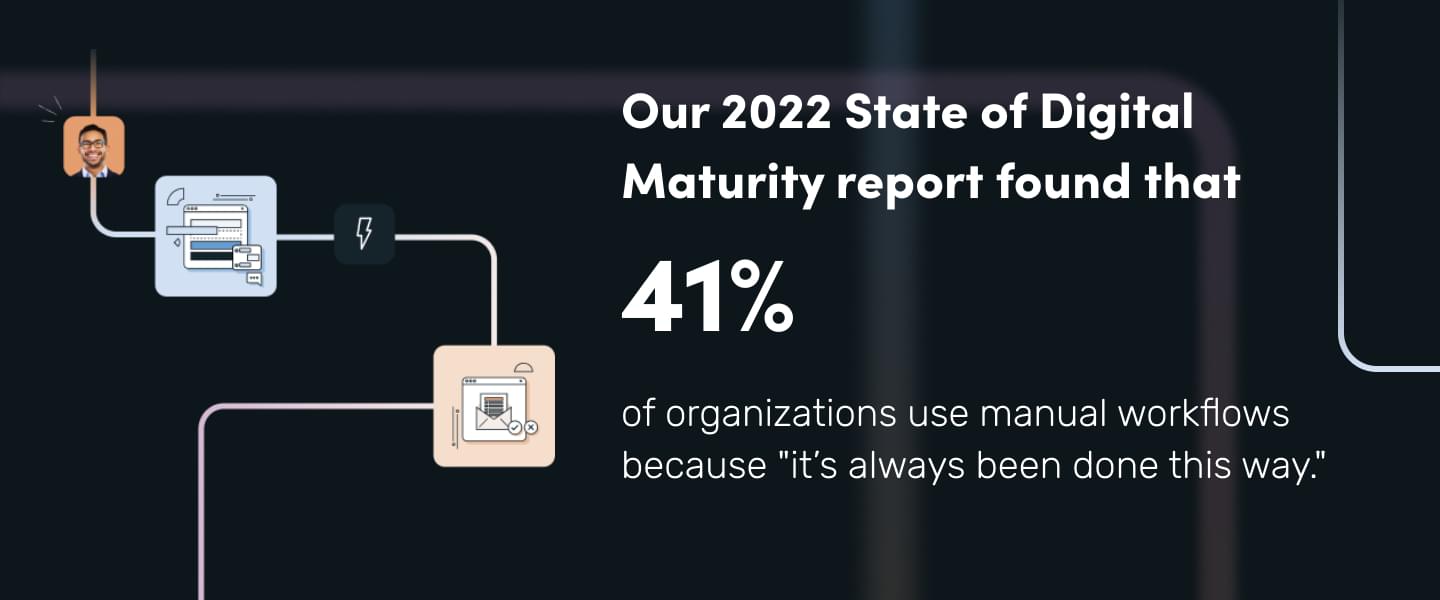You might be familiar with the term tech debt, but do you know about process debt?
I don’t recall ever hearing this term before. Although I know and understand what tech debt is, it’s not something I worry about in my role as a marketer. But process debt? That sounds like something that could impact me.
So when Prabhjot Singh mentioned the term during a Practically Genius podcast episode, I had to get him to dive in deeper. What is process debt, why is it an issue, and how can it be fixed? Let’s dig in.

Listen Now: Rather listen than read? Get all of Prabjhot’s insights on process debt, automation, and improving efficiency by listening to his Genius Spotlight episode Automation Can’t Save You from Broken Processes.
What is process debt?
Think about the last time you added a new tool into a current process. Before implementing the new tool, did you do a review of the existing process? If not, you may be creating process debt.
In the podcast episode, Prabhjot explained that we often believe tools will modernize processes, but that thinking is a bit backwards. The truth is that software on its own cannot fix a broken process. Until the underlying process issues are addressed, process debt will continue to accumulate. He went on to state:
Another way to explain process debt is to consider how long it has been since you’ve audited a process from beginning to end. If it’s been a while, there are likely bottlenecks, inefficient steps, and unnecessary actions hidden within the scope of the process.
A process that worked effectively and efficiently a year ago may not be as productive now as it was then. As expectations, people, resources, and tools change, processes must also change to ensure they are running as optimally as possible.
If you’re looking for a definition, Blueprint seems to put it best when they say, “Process debt refers to inefficiencies, waste, and redundancies that have accumulated in workflows over time.”
Related: How Workflow Automation Impacts Digital Maturity
What causes process debt?
As with most business issues, there’s not one singular cause for process debt. But there are some common issues that allow process debt to exist and grow. Here are just a few reasons why process debt might be an issue within your organization. Spoiler: some can’t be avoided.
Company Culture
Our 2022 State of Digital Maturity report found that many organizations still run on inefficient processes. Why? Because they're stuck in the status quo.
In fact, when asked why organizations use manual workflows, the number one response was “it’s always been done this way.” It seems that a resistance to change and lack of innovation creates a lot of process debt over time.

Have you ever run into a process and asked, “why do we do it this way?” but been unable to identify a solid answer? Culture is likely the reason for your process debt. Have you tried to fix an inefficient process and felt intense pushback? That’s also a strong signal that culture is causing issues.
Read Next: 3 Simple Ways to Make Change Easier at Work
Capacity
Have you ever found yourself saying, “I’d love to fix this if I only had the time?” Has a process that needs tweaking sat on your to-do list for months? You’re not alone—capacity is a leading reason why process debt runs rampant within orgs.
Your capacity to tackle process updates may flux from quarter to quarter and year to year. But if you’re constantly unable to complete necessary process audits and improvements, it may be time to chat with your manager or senior leader about the issue.
But it’s not just capacity that causes these efficiency problems to pile up. There’s also the issue of prioritization. Once you have the capacity to take on process updates, you need to make that a priority on your to-do list.
Time
Process debt occurs naturally over time to practically any type of business or organization. As your company ages, customer expectations change, employees turnover, and technology advances. These factors all impact how processes work, and eventually they will need fine-tuning to ensure they continue running smoothly.
This, unfortunately, means you can never truly get rid of process debt. But if you put the right strategies in place, you can mitigate it.

How do you fix process debt?
As mentioned, process debt can never be completely avoided, but it can be minimized. By following the three steps below, you can build habits into your workday and workplace culture that curb the buildup of these sneaky inefficiencies.
1. Document Processes
Prabhjot believes a common problem is we think we know how processes work, but in actuality, we’re not completely clear on all the steps, people, and tools involved. That’s why he advocates for gaining a holistic view of a process from start to finish.
Keeping detailed, accurate, and up-to-date documentation on processes provides anyone, at anytime, a comprehensive and step-by-step overview. Be sure to keep this documentation in a centralized location so employees can easily access it as needed.
Here are some reasons documentation is important:
- Allows you to visualize a process from start to finish
- Helps new employees to understand systems and day-to-day operations
- Ensures vendors can get up to speed on the current state quickly
- Provides a holistic view of people, tools, and steps involved in a process
- Creates consistency across teams and departments
- Protects legacy knowledge from being lost with employee turnover
Beginning with in-depth and clear documentation sets all teams up for success in combatting process debt. It may be time-consuming in the beginning, but your future self will thank you.
2. Track Data and Collect Feedback
One issue that’s clear in our 2022 State of Digital Maturity report is that many organizations lack data tracking. In fact, we found that organizations in lower stages of digital maturity are less likely to be able to track data across a variety of business functions and processes.
By tracking data on systems, proccess, and tools, you can identify process debt issues as they arise. Some data to consider tracking includes which processes take the most manual work, which steps within processes take the most time, and which systems require the most employee upkeep.
.jpg)
It’s also important to make collecting feedback a part of your workplace culture. Any time you launch a new process, make providing and collecting feedback easy. It can be as simple as creating a feedback form and circulating it to team members on a consistent basis. Collecting, analyzing, and acting on this feedback minimizes process debt because it offers more opportunities for process reviews. As you collect feedback in real-time, you can begin to make adjustments as necessary instead of letting problems fester and grow.
3. Audit Regularly
If you don’t include process audits in your quarterly or yearly planning, now is the time to make them a priority. It’s recommended to audit at least once every few years, but this will flux depending on the workflow type and complexity.
What should you do during a process audit? It’s a good idea to have two people test the system from beginning to end. One tester should be a typical user, while the second tester should be new to the process. Why? Because they will come into the test without preconceived notions and with fresh eyes.
Each tester should review process documentation and run through the workflow with a critical eye. Any areas for improvement, discrepancies between flow and documentation, and ideas should be noted. From there, testers can collaborate with those involved in the process steps to suggest improvements and implement any changes.

Start Minimizing Process Debt Now
Although you can’t ever eliminate the process debt problem, you can establish some strong strategies to minimize and mitigate it. The tips above can help you build more efficient processes so that you can focus on your most impactful work.
Dive into more tips on how to handle process debt, use automation, and empower employees through technology by listening to Prabhjot’s Practically Genius podcast episode now!











